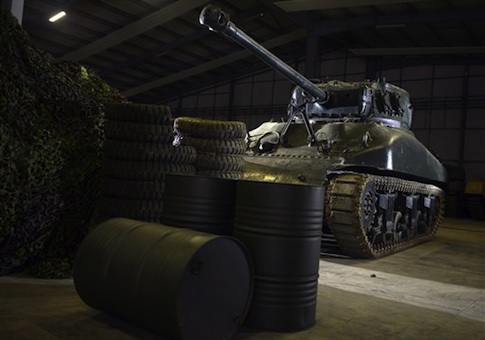Shortly after inspecting the ragtag nature of American troops at the African front in Patton (1970), Generals Omar Bradley and George S. Patton discuss the weakness of American tanks compared to their German counterparts.
"Their tanks are diesels—even when we managed to hit them they kept running," Bradley (Karl Malden) says. "The men call our tanks ‘Purple Heart Boxes.’ One hot piece of shrapnel and the gasoline explodes."
"I warned them about the tanks," Patton (George C. Scott) sniffs. But we never really see the problems with them. We only hear about them. Indeed, in Patton’s first major tank battle, the camera is barely interested in the troops at all. We see some shells exploding and Germans falling like tenpins and some tank movements. But the camera’s focus is generally on Patton himself. The camera zooms in on an oncoming German tank column as he raises binoculars to his eyes, then pushes in on him as the battle begins. We see what he sees. We experience strafing runs from oncoming airplanes as he experiences them.
"Rommel, you magnificent bastard!" Patton cries, his face taking up the full frame as the battle turns into a rout. "I read your book!"
Patton is a movie enamored with the Great Man Theory of history, and George S. was undoubtedly a great man. So we focus on him and his eagle-eyed, God-like view of war: Strategy and tactics matter, not the ant-like individual.
Fury is the opposite. It’s a movie about the men on the field, the ones dying in those Purple Heart Boxes. It’s about the grubby dirtiness of conflict, the blood and guts and sacrifice. Its opening scene is an explicit rejection of the Great Man theory.
Out of the fog we see a tall rider on a beautiful white horse: a German officer. The camera sits still; he saunters toward us. The ruins of American tanks litter the landscape. As this officer finally enters the full of the frame, we start to track. A wild man leaps from the top of a tank, knocking the officer off his steed, and stabbing him repeatedly and gruesomely in the face.
That wild man is Don ‘Wardaddy’ Collier (Brad Pitt). He and his tank-mates—Boyd ‘Bible’ Swan (Shia LaBeouf), Trini ‘Gordo’ Garcia (Michael Peña), and Grady ‘Coon-Ass’ Travis (Jon Bernthal)—are deep in German territory, rolling toward Berlin. They’ve been lucky up to this point: We are told that they have been the only tank crew not to lose a man yet.
But they’ve finally lost one. And now they need a new guy.
The newbie is Norman Ellison (Logan Lerman), a fresh face replacing "the best gunner in the army." We see the costs of his inexperience early on: As a column of tanks moves along a German road, he refuses to fire on a young German with a rocket. But the German gets his shot off, hitting the tank in front of Norman’s. The Purple Heart Box explodes. A man on fire clambers out of its turret, putting a bullet in his own head to end the pain.
Fury is one of few movies to show combat from the point of view of a tank crew. It is a hard life. Armor may provide some cover from bullets, but a tank is also a metal box: fire stays inside, blood has nowhere to go. One of the more horrifying moments comes from simple cleanup duty: Norman’s first job is to remove half of a man’s face and sop up several pints of his blood from the floor of the vehicle.
The film’s intensity is its strength. There hasn’t been an American war film this interested in the mind-numbing brutality of war since Saving Private Ryan. It is anti-war in that its heroes are weary and bloody and forced to make hard choices. But it is not anti-American. Writer-director David Ayer does not demonize GIs.
This is not to say that the characters are saints. These are fully realized, battle-hardened men with needs and desires. At times difficult to watch thanks to its unblinking view of the horrors of combat, Fury’s cast keeps the audience rapt even when it wants to look away. Special credit goes to LaBeouf, who turns in a career-best performance as Bible, while Bernthal imbues Coon-Ass with the perfect mix of aggression and vulnerability.
Though unlikely to crack the Oscar conversation, as some predicted earlier in the year, Fury is a well crafted, incredibly taut war film, one that sets aside the Great Man Theory of war and instead focuses on war-fighting men.
